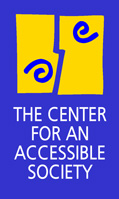
DISABILITY
ISSUES
INFORMATION
FOR
JOURNALISTS
ABOUT
THE CENTER
Getting it right -- and not getting it at all
Note to readers: links to news articles may not work after a few weeks, as news media remove current stories to their archives. The link may take you to the archives section, where, for a fee, you can view the article.
Nov. 21, 2000 -- A Nov. 13 Los Angeles Times Times story that largely gets it right about access problems seems to be the result of a reporter who "gets it" about wheelchair access barriers.
The story, which ran in the Metro section of the Orange County Edition, was headlined, "The Safety Zone: 8 Blocks of Hurdles for Wheelchair." Hicks' reporting involved going along with a Cal State Fullerton junior who used a motorized wheelchair. "I had interviewed numerous wheelchair users about problems they face trying to get around," Hicks wrote. "Many of the obstacles, they say, come from lack of awareness from some of the rest of us. But I wanted to see what they were talking about for myself.
"It was quite an education, one I hadn't expected," he continues. The education Hicks got he gives to readers without sappiness or the typical comments about "courage" that all too often are found in such stories. Nor did Hicks do what too many reporters have been persuaded at times by advocates to do -- get in the wheelchair themselves. Such ploys often backfire, as reporters become overwhelmed and focus more on their feelings than on the problems with access with which they're presented. Here Hicks covers the territory as a journalist should, keeping his emotions out of it but reporting the problems.
"The first block was fine.
"The second block, the sidewalk was completely barricaded by a pickup parked in someone's driveway. Which, of course, is against the law. These are public sidewalks. . . " (Use http://www.latimes.com/editions/orange/ocnews/20001113/t000108771.html to retrieve the story, which is in the archives but can be read for free for two weeks. The companion story, Hicks' interviews with wheelchair users, can be retrieved through http://www.latimes.com/editions/orange/ocnews/20001113/t000108761.html Hicks' email is jerry.hicks@latimes.com)
"Rather than saying that Hicks 'gets it,' I'd say that he's aware that he doesn't completely 'get it' and so doesn't have the story written before his investigation," Chapman University professor Art Blaser told us. "I talked with him via phone when he was putting this story together, and my perception was that he was unusually thoughtful." Blaser hopes Hicks will do more disability stories in the Times.
The next day the L.A. Times carried another disability story, "Economic Boom Leaves Disabled Workers Behind," accessible via http://www.latimes.com/news/state/updates/lat_disable001118.htm -- L.A. Times' reporter E. Scott Reckard's piece on the controversial Cornell study we reported on in the 11/7/00 E-letter.
Blaser characterizes the L.A.Times's ongoing coverage of disability issues as "good but uneven."
On the same day as Hicks' piece," says Blaser,"they ran an op-ed, "Waiting for Danger Can Prove Deadly to the Mentally Ill," which, says Blaser, "reflects the idea that forced treatment is okay and that lots of people are imprisoned because of not having had forced treatment rather than because they weren't given a 'fair trial.'"
This article, accessible via http://www.latimes.com/news/comment/20001113/t000108781.html represents the views of the controversial Treatment Advocacy Center -- controversial within the psychiatric survivor movement, that is.
The term "forced treatment" that Blaser uses reflects his own knowledge of the perspective presented by the psychiatric survivor movement, whose members often contend that their group's positions are taken as being even less credible than the positions taken by the "mainstream" disability rights movement. It is likely that The Times is not fully aware of the controversial nature of Torrey's statements --- perhaps not even aware at all that there are other positions than his on the topic.
For more on the position of the psychiatric survivor movement, read the articles and follow the links at "The Dark Side of Psychiatry" at http://www.oikos.org/antipsicen.htm#Madness"